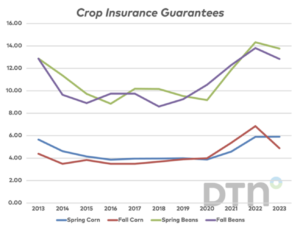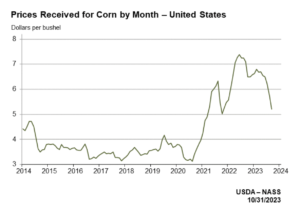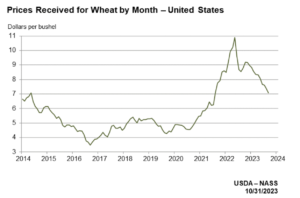Beef prices are projected to continue increasing as U.S. beef production declines with no signs of a cattle herd rebuild. Additionally, cheap beef may soon become further out of reach…
Harvest Crop Insurance Prices Below Spring Guarantees, as White House Highlights Rural Investments
DTN writer Katie Micik Dehlinger reported yesterday that, “The average daily close of the December corn futures contract was $4.88 during October, while the November soybean contract was $12.84 per bushel.
“The averages are an important piece of price discovery that underpins many crop insurance policies, which use the higher of either the harvest price or the spring projected price to calculate indemnity payments. The projected prices are an average of the new-crop futures contracts’ closes during February. They came in at $5.91 per bushel of corn and $13.76 per bushel of soybeans.
“For corn, this breaks a three-year streak of higher corn prices at harvest.”

Yesterday’s article noted that, “DTN Lead Analyst Todd Hultman said the deterioration of corn prices over the growing season will likely trigger payments on 85% coverage policies without a yield loss. At lower coverage levels, which usually range between 70%-80%, farmers will also likely need a yield loss to trigger a payment.”
Elsewhere, in its monthly Agriculture Prices report yesterday, the USDA’s National Agricultural Statistics Service (NASS) highlighted prices received by farmers in September, and stated that, “The corn price, at $5.21 per bushel, is down 52 cents from last month and $1.88 from September 2022.”

“The soybean price, at $13.20 per bushel, is 90 cents lower than August and $1.00 lower than September a year earlier.”

And for wheat, NASS indicated that, “The September price for all wheat, at $7.07 per bushel, is 28 cents lower than August and $1.71 lower than September 2022.”

Meanwhile, Reuters News reported today that, “Chicago wheat prices fell on Wednesday to match Tuesday’s three-week low on strong supplies from Russia, lackluster demand and less concern about small crops in southern hemisphere exporters.”
“Prices rose in October due to fears that dry weather would further reduce yields in Argentina and Australia, but rain has fallen in both countries. Wheat is now nearing September’s three-year low of $5.40.”
Also today, Reuters writers Jarrett Renshaw and Leah Douglas reported that,
Major U.S. airlines and aviation companies joined ethanol companies to send a letter to the Biden administration on Wednesday backing a regulatory change that would make it easier for sustainable aviation fuel (SAF) made from corn-based ethanol to qualify for federal subsidies.
“The Inflation Reduction Act, President Joe Biden’s signature climate law, requires SAF producers to use an emissions model developed by the International Civil Aviation Organization (ICAO), or a ‘similar methodology,’ to show their fuel cuts emissions over gasoline by 50% to secure the subsidies.”
Renshaw and Douglas explained that, “Airlines including Delta, JetBlue, and Southwest, and companies like GE Aerospace and Boeing, said in the letter to Treasury Secretary Janet Yellen that the administration should allow the use of the Department of Energy’s Greenhouse Gases, Regulated Emissions and Energy Use in Technologies (GREET) model in addition to the one developed by ICAO, echoing a request from the ethanol industry.
“The ethanol industry believes the GREET model is more likely than the ICAO model to bear out the required climate benefits to secure IRA subsidies.”
And New York Times writer Lisa Friedman reported today that, “The White House on Wednesday will announce more than $5 billion in funding for agriculture, broadband and clean energy needs in sparsely populated parts of the country as President Biden travels to Minnesota to kick off an administration-wide tour of rural communities.”
The Times article stated that, “The White House has called the next two weeks of events the ‘Investing in Rural America Event Series.’ It includes more than a dozen trips by Mr. Biden as well as cabinet secretaries and other senior administration officials. The White House said in a statement that the tour would highlight federal investments that ‘are bringing new revenue to farms, increased economic development in rural towns and communities, and more opportunity throughout the country.’
“Mr. Biden will be joined on Wednesday by Tom Vilsack, the agriculture secretary. Against the backdrop of a family farm that uses techniques to make crops more resilient to climate change, they will announce $1.7 billion for farmers nationwide to adopt so-called climate-smart agriculture practices.”





